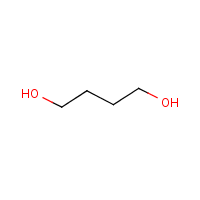1,4-Butanediol
Agent Name
1,4-Butanediol
CAS Number
110-63-4
Formula
C4-H10-O2
Major Category
Other Classes

Synonyms
1,4-BD; 1,4-Butylene glycol; 1,4-Dihydroxybutane; 1,4-Tetramethylene glycol; Agrisynth B1D; Butane-1,4-diol; Butanediol; DIOL 14B; Sucol B; Tetramethylene 1,4-diol; Tetramethylene glycol; [ChemIDplus]
Category
Alcohols and Polyols, Other
Description
Colorless liquid; [Hawley] Hygroscopic; [CAMEO] Colorless liquid or yellow melt; mp 19-20 deg C; [MSDSonline]
Sources/Uses
Used as a chemical intermediate for tetrahydrofuran and other acetylenic chemicals; as a monomer for polybutylene terephthalate resins; as a chain extender for polyurethane resins; as an intermediate in polyester resins; in the production of 1,4-butanediol dimethanesulfonate (myleran); Also used as a humectant; [HSDB] Used as a solvent, an intermediate for plasticizers, and a cross-linking agent in polyurethane elastomers; [Hawley]
Comments
Emergency treatment: "Glycols"; [HSDB] Pregnant female mice had sedation at 300-600 mg/kg/day by gavage; Increased fetal skeletal defects at 600 mg/kg/day; [NTP] A CNS depressant; [ICSC] A mild skin, eye, and respiratory tract irritant; Metabolized to gamma- hydroxybutyric acid, a CNS depressant; [Reference #1] Causes somnolence and change in righting reflex in lethal-dose feeding studies of rats; [MSDSonline]
Reference Link #1
Biomedical References
Exposure Assessment
Vapor Pressure
0.0105 mm Hg
Lethal Concentration
LCLo (rat) = 15,000 mg/m3/4h
Explanatory Notes
Flash point = 121 deg C; [ICSC] VP from ChemIDplus;
NFPA
must be preheated
Adverse Effects
Neurotoxin
Acute solvent syndrome
Diseases, Processes, and Activities Linked to This Agent
Diseases
Occupational diseases associated with exposure to this agent:
Processes
Industrial Processes with risk of exposure: